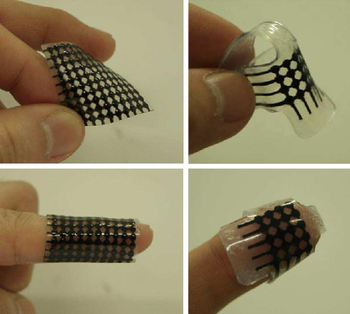June 6, 2008 feature
Researchers Design Band-Aid-Size Tactile Display

Currently, we get most of our information from computers through visual and audio features. But as researchers from Korea point out, the most widespread sense on the human body is touch. While some tactile computer devices do exist, the researchers are trying to take full advantage of this overlooked sense with the development of a tactile display that can be wrapped around your finger like a band-aid.
In an upcoming issue of IEEE Transactions on Robotics, Ig Mo Koo, Hyouk Ryeol Choi, and co-authors from Sungkyunkwan University and the University of Nevada explain how they have designed the innovative tactile display based on soft actuator technology. Overcoming the rigidity and bulkiness of current devices, the new display is soft and flexible enough to be wrapped around almost any part of the human body, such as the fingertip, palm, or arm.
“The big advantage of a wearable tactile display compared to a normal tactile display is flexibility,” Koo told PhysOrg.com. “When you apply a normal device to a non-flat surface like human skin, it is impossible to stimulate the whole skin through its shape. In the case of a wearable tactile display, however, it can be applicable to many kinds of surfaces without the limitation of stimulus area because of its flexibility.”
The researchers hope that the soft display might provide a means of communication for the visually impaired (for example, as a Braille display). It could also have applications as a tactile display cloth, virtual reality keyboard, tele-surgical glove, tele-feeling transferring system, and more.
“Let’s assume someone needs a glove-type wearable tactile display,” Koo said. “When we make it using a normal device, stimulus elements can be attached only in a limited area. But if we develop it as a wearable tactile display, it is possible to not only make a glove-type in the process of manufacturing, but also apply stimulus elements on the whole part of the glove.”
The key material to the display is an electroactive polymer that can stimulate the skin without using any additional electromechanical transmission. The polymer consists of eight layers of dielectric elastomer actuator films which have been sprayed with electrodes in a specific pattern.
Along with a protective layer to separate the electrodes from the skin, the entire polymer sheet is about 210 micrometers thick. In their study, the researchers fabricated an 11 x 14 mm sheet with Velcro on the edges, and rolled it up in the shape of a thimble to be worn on the finger.
The display can convey information to the wearer when the electrodes induce a voltage across the films. A voltage causes the films to compress down and expand outward. In doing so, the films put pressure on the wearer’s skin, inducing a “mild sensation.” Like most polymers, the device is hyperelastic, meaning that it can experience large amounts of elastic strain and recover its original shape.
This simple stimulation mechanism, which doesn’t require complex electronics, is one of the greatest advantages of the soft tactile display compared with current displays. Its other benefits include efficient power usage, cost-effectiveness, and easy fabrication. As the researchers note, the new display has lower power and displacement values than is considered optimal, which may limit its applications to specific areas.
Koo added that, in the future, the team plans to improve display performance, as well as develop applications such as a tele-feeling transferring system and glove-type tactile display device.
More information: Koo, Ig Mo; Jung, Kwangmok; Koo, Ja Choon; Nam, Jae-do: Lee, Young Kwan; and Choi, Hyouk Ryeol. “Development of Soft-Actuator-Based Wearable Tactile Display.” IEEE Transactions on Robotics. To be published.
Copyright 2008 PhysOrg.com.
All rights reserved. This material may not be published, broadcast, rewritten or redistributed in whole or part without the express written permission of PhysOrg.com.





















